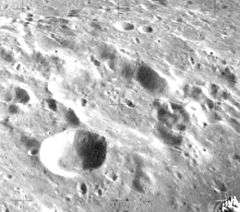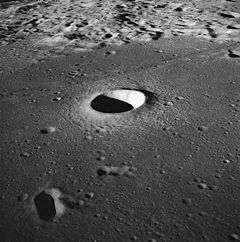Hypatia (crater)
|
Lunar Orbiter 4 image | |
| Coordinates | 4°18′S 22°36′E / 4.3°S 22.6°ECoordinates: 4°18′S 22°36′E / 4.3°S 22.6°E |
|---|---|
| Diameter | 41 × 28 km |
| Depth | 1.4 km |
| Colongitude | 338° at sunrise |
| Eponym | Hypatia of Alexandria |
Hypatia is a lunar crater that lies along the northwest edge of Sinus Asperitatis, a bay on the southwest edge of Mare Tranquillitatis. The nearest crater with an eponym is Alfraganus to the west-southwest. However, farther to the south-southeast, across the lunar mare, is the prominent crater Theophilus.
Hypatia is an asymmetrical formation with a rugged, irregular outer rim that is cut through by narrow clefts in several locations. It is generally longer along an axis running to the north-northwest, with the widest outward bulge occurring on the west side at the northern end. It resembles a merger of several crater formations that have gained a common interior floor. Attached to the exterior rim along the southwest is the satellite crater Hypatia A, a more symmetrical, bowl-shaped crater.

About 70 kilometers to the north of Hypatia is a system of linear rilles designated Rimae Hypatia. This runs for a length of about 180 kilometers across the Mare Tranquillitatis, and generally follows a course to the south-southeast.
Satellite craters
By convention these features are identified on lunar maps by placing the letter on the side of the crater midpoint that is closest to Hypatia.
| Hypatia | Latitude | Longitude | Diameter |
|---|---|---|---|
| A | 4.9° S | 22.2° E | 16 km |
| B | 4.6° S | 21.3° E | 5 km |
| C | 0.9° S | 20.8° E | 15 km |
| D | 3.1° S | 22.7° E | 6 km |
| E | 0.3° S | 20.4° E | 6 km |
| F | 4.1° S | 21.5° E | 8 km |
| G | 2.7° S | 23.0° E | 5 km |
| H | 4.5° S | 24.1° E | 5 km |
| M | 5.3° S | 23.4° E | 28 km |
| R | 1.9° S | 21.2° E | 4 km |
References
- Andersson, L. E.; Whitaker, E. A. (1982). NASA Catalogue of Lunar Nomenclature. NASA RP-1097.
- Blue, Jennifer (July 25, 2007). "Gazetteer of Planetary Nomenclature". USGS. Retrieved 2007-08-05.
- Bussey, B.; Spudis, P. (2004). The Clementine Atlas of the Moon. New York: Cambridge University Press. ISBN 978-0-521-81528-4.
- Cocks, Elijah E.; Cocks, Josiah C. (1995). Who's Who on the Moon: A Biographical Dictionary of Lunar Nomenclature. Tudor Publishers. ISBN 978-0-936389-27-1.
- McDowell, Jonathan (July 15, 2007). "Lunar Nomenclature". Jonathan's Space Report. Retrieved 2007-10-24.
- Menzel, D. H.; Minnaert, M.; Levin, B.; Dollfus, A.; Bell, B. (1971). "Report on Lunar Nomenclature by the Working Group of Commission 17 of the IAU". Space Science Reviews. 12 (2): 136–186. Bibcode:1971SSRv...12..136M. doi:10.1007/BF00171763.
- Moore, Patrick (2001). On the Moon. Sterling Publishing Co. ISBN 978-0-304-35469-6.
- Price, Fred W. (1988). The Moon Observer's Handbook. Cambridge University Press. ISBN 978-0-521-33500-3.
- Rükl, Antonín (1990). Atlas of the Moon. Kalmbach Books. ISBN 978-0-913135-17-4.
- Webb, Rev. T. W. (1962). Celestial Objects for Common Telescopes (6th revised ed.). Dover. ISBN 978-0-486-20917-3.
- Whitaker, Ewen A. (1999). Mapping and Naming the Moon. Cambridge University Press. ISBN 978-0-521-62248-6.
- Wlasuk, Peter T. (2000). Observing the Moon. Springer. ISBN 978-1-85233-193-1.

